Braising Method is culinary magic. Imagine taking a tough, inexpensive cut of meat and transforming it into a tender, flavorful masterpiece. That’s the power of braising. Yet, it’s not just for meats—it works wonders for vegetables, legumes, and even tofu, making it one of the most versatile cooking techniques you can master. But how exactly does this process work? Why is it so effective at coaxing flavor and tenderness from humble ingredients?
This blog will guide you through everything you need to know about braising method, from its history and benefits to pro tips and mistakes to avoid. Whether you’re a beginner or a seasoned chef, you’ll feel confident enough to create your first braised dish by the end. Let’s get started!
What is Braising Method?
At its core, braising is a combination cooking method that uses both dry and moist heat to transform ingredients. It typically starts with searing food in a hot pan (dry heat) to develop flavor before simmering it slowly in liquid (moist heat) over low heat.
It’s the ultimate slow-and-low technique. The magic happens when the combination of heat, liquid, and time breaks down tougher fibers, making everything melt-in-your-mouth tender. Braising works especially well for tougher cuts of meat, root vegetables, and robust greens that require longer cooking to unlock their flavors.
What Makes Braising Different?
If you’re wondering how braising method differs from similar techniques, here’s a quick comparison:
- Braising vs. Stewing: While stewing submerges ingredients completely in liquid, braising uses less liquid, allowing the ingredients to be partially submerged.
- Braising vs. Slow Cooking: Slow cooking relies entirely on moist heat and doesn’t usually include an initial sear, which is essential in braising to build richer flavor.
It’s a technique rooted in precision and patience, but the rewards? Worth every minute.
A Quick History of Braising Method
Braising may sound fancy, but it’s one of the oldest and most universal cooking techniques used in kitchens worldwide. Its origins date back to a time long before refrigeration when preserving and tenderizing tough cuts of meat was essential.
- French roots: The term “braising” comes from the French word “braiser,” a hallmark of classic French cooking. Dishes like coq au vin and pot-au-feu are rooted in this technique.
- Across cultures: Braising thrives globally. China boasts red-braising (hong shao rou), Morocco offers rich, spiced tagines, and Italy celebrates with dishes like osso buco.
- Timeless versatility: Over generations, braising evolved from being a necessity for cooking inexpensive ingredients to a gourmet technique championed in fine dining—and (thankfully) our home kitchens too.
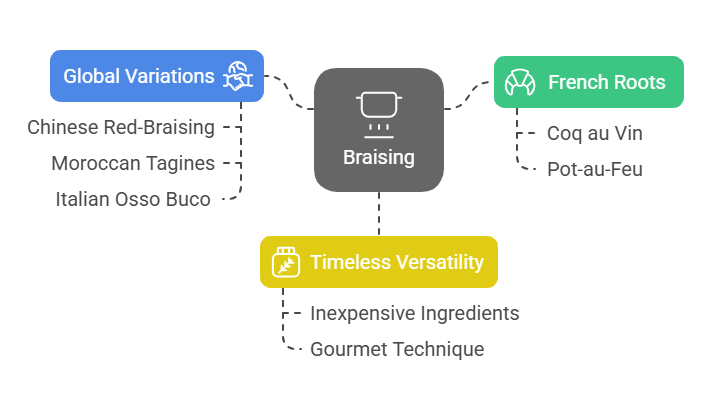
The Benefits of Braising Method
Braising isn’t just about tender food; it comes with numerous other advantages:
1. Tenderizes Tough Cuts
Tough meats like chuck roast or pork shoulder might seem challenging to cook. Braising works its magic by breaking down the collagen in these cuts into gelatin, which creates rich, succulent textures.
2. Infuses Bold Flavors
When you braise, the food sits and cooks in a flavorful liquid (like wine, broth, or tomato sauce) infused with herbs and aromatics. The result? A dish packed with depth and character.
3. Cost-Effective
Budget-friendly meats and vegetables shine when braised. Why splurge on pricey cuts when this technique makes the most of affordable options while delivering luxury-level taste?
4. Versatility
It’s not just for meat! Braise vegetables like eggplant, cabbage, or carrots, or go plant-based with jackfruit or tofu. Nearly anything benefits from the braising process.
5. Nutrient Retention
Braising uses minimal liquid and a covered vessel, which helps lock in nutrients that might otherwise be lost in long cooking processes.
Simply put, braising is both practical and delicious.
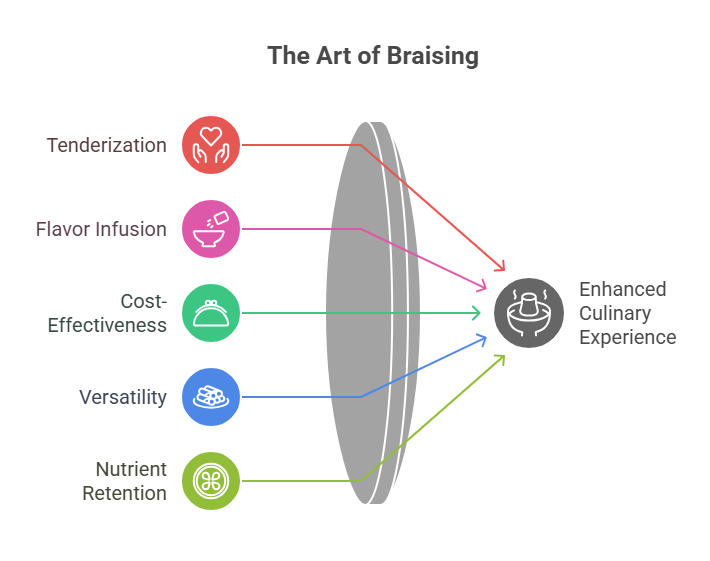
Techniques for Braising
1. The Right Equipment
Braising method requires the right tools for even heat distribution and consistent results:
- Dutch ovens are ideal. Their heavy, cast-iron material locks in moisture and distributes heat evenly.
- Braising pans or any deeper, oven-safe cookware with a tight-fitting lid will also work.
- Slow cookers are a more automated alternative but may lack the depth of flavor developed during traditional searing.
2. The Process Simplified
Mastering braising boils down to a few golden steps. Here’s the process broken down:
Step 1: Sear the Ingredients
- Heat your pot and brown the meat (or vegetables) to create a deep, flavorful crust. This step develops umami—don’t skip it!
Step 2: Deglaze the Pan
- After searing, deglaze by pouring in liquid (wine, broth, or stock) to scrape up the delicious browned bits stuck to the bottom.
Step 3: Add Aromatics and Liquid
- Add herbs, garlic, onions, or spices for depth. Pour just enough liquid to come halfway up the ingredients.
Step 4: Simmer Gently
- Cover with a tight-fitting lid and cook on low heat, either on the stovetop or in the oven. Cook times vary, but low and slow is the key.
Step 5: Finish and Serve
- Allow the dish to rest slightly. Adjust seasoning and serve with your favorite sides.
3. Choosing Ingredients Wisely
- Best Cuts for Braising: Chuck roast, short ribs, lamb shanks, chicken thighs.
- Vegetarian Options: Eggplant, jackfruit, potatoes, even greens like chard.
- Liquid Options: Wine (red/white), chicken or vegetable stock, coconut milk, or tomato-based sauces.
4. Pro Tips for Perfect Braising
- Balance is key. Too much liquid dilutes flavor; too little may dry out the dish.
- Use acidic ingredients like tomatoes or vinegar to cut through rich fats.
- Be patient. Great braising results come from cooking low and slow.

Popular Braised Recipes You Must Try
Want to put these techniques into action? Here are six classic recipes to explore:
- Classic French Coq au Vin
Braised chicken in red wine with mushrooms and onions.
- Italian Osso Buco
Braised veal shanks served with a tangy gremolata.
- Chinese Red-Braised Pork Belly (Hong Shao Rou)
Sweet and savory pork belly with soy sauce and aromatic spices.
- Moroccan Lamb Tagine
Tender lamb braised with apricots, almonds, and warm spices.
- Vegetarian Braised Eggplant
Eggplant simmered in garlic, soy, and ginger for Asian-inspired flavor.
- Braised White Beans with Rosemary
A comforting plant-based dish bursting with herby goodness.
Try one, post your masterpiece on Instagram, and tag us—we’d love to see it!
Common Mistakes to Avoid
Even seasoned cooks slip up with braising. Here’s how to sidestep common mistakes:
- Wrong-sized pot: Too big? Ingredients dry out. Too small? Uneven cooking.
- Skipping the sear. No sear means no flavor.
- Overcrowding the pan. Keep your ingredients spaced for even browning.
- Excess liquid. Your food should braise, not stew.
Master these, and you’re well on your way to becoming a braising pro.
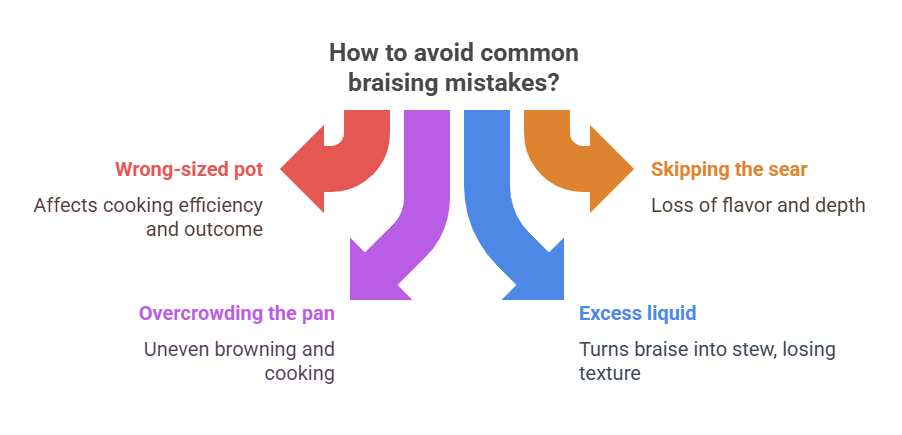
Braising Method vs. Other Cooking Methods
Use this method comparison to decide when to braise:
- Braising: Partial liquid coverage. Low, slow cook.
- Stewing: Fully submerged. Higher liquid content.
- Slow Cooking: Countertop convenience; lacks a searing step.
- Roasting: Dry heat only, typically at a higher temperature.
Each technique shines in specific situations, but braising wins for its balance of flavor-depth and versatility.
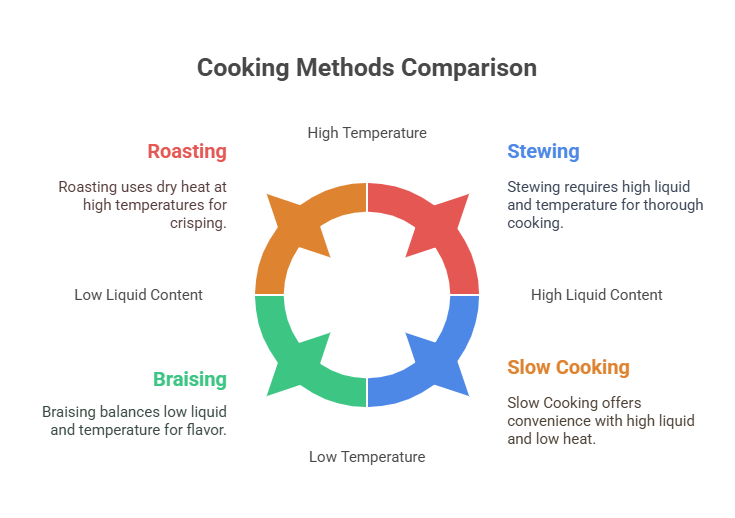
Why Braising Method is a Must-Learn Technique
Braising method isn’t just for seasoned chefs. It’s a forgiving, beginner-friendly technique that delivers elevated results. Plus, it’s the perfect combination of indulgence and practicality—feeding your family deeply satisfying meals without breaking the bank.
Try Braising Method Today!
Ready to give braising a go? Whether it’s a rich beef short rib or a rustic veggie medley, this technique will take your cooking to the next level. For more inspiration, check out our comprehensive Cooking Methods Pillar Post or browse our Combination Cooking Guide.
And when you try your first braised dish, don’t be shy—share your creation with us on social media, and show off your new skills! Happy braising!
📌 Stay connected with us!
- Follow us on Instagram: @RoastedKitchen25 for daily cooking inspiration.
- Tag us in your creations using #RoastedKitchenbraised—we’d love to see what you make!
- Subscribe to our newsletter for exclusive recipes, expert tips, and kitchen hacks straight to your inbox!
FAQ for Mastering the Art of Braising Method: A Guide to Perfectly Tender Meals
What is braising method?
Braising is a cooking technique that combines dry and moist heat. The process begins with searing ingredients in a hot pan (dry heat) to develop deep flavors, followed by simmering them slowly in a small amount of liquid (moist heat). This method tenderizes tough cuts and infuses dishes with rich flavor.
What are the benefits of braising method?
Braising has many advantages, including:
- Tenderizing tough cuts of meat by breaking down collagen into gelatin.
- Infusing bold flavors from liquids, herbs, and aromatics.
- Cost-effectiveness by using affordable cuts of meat and vegetables.
- Versatility with both meat-based and vegetarian dishes.
- Nutrient retention since the cooking process locks in vitamins and flavors.
How is braising different from stewing?
The key difference is the amount of liquid used:
- Braising: Ingredients are partially submerged, allowing them to retain their texture.
- Stewing: Ingredients are fully submerged, resulting in a softer consistency.
What’s the difference between braising and slow cooking?
Braising includes an initial searing step, which develops deeper flavor through browning. Slow cooking, however, typically skips this step and relies solely on moist heat over a long period.
What is the best cookware for braising method?
The best equipment for braising includes:
- Dutch ovens: Heavy, oven-safe pots with tight-fitting lids that distribute heat evenly.
- Braising pans: Wide and deep pans made for stovetop-to-oven cooking.
- Slow cookers: A more automated option, though they may not develop as much flavor since they lack a searing step.
What are the best ingredients for braising method?
For meats, choose tough cuts high in collagen like:
- Chuck roast, short ribs, pork shoulder, lamb shanks, and chicken thighs.
For vegetarian options, try: - Eggplant, potatoes, jackfruit, leafy greens, or white beans.
For liquids, popular choices include stock, wine, coconut milk, or tomato sauce.
What liquids work best for braising method?
Liquids play a crucial role in braising, adding flavor and moisture. Try these:
- Broth/stock: Chicken, beef, or vegetable stocks add umami.
- Wine: Red or white wine enhances depth and complexity.
- Tomato-based sauces: Great for richness and tang.
- Coconut milk: Perfect for creamy and aromatic dishes.
What are the common mistakes to avoid when braising?
To ensure successful braising, avoid these pitfalls:
- Using too large or too small a pot, which can either dry out ingredients or cause uneven cooking.
- Skipping the sear, sacrificing flavor.
- Overcrowding the pan, leading to steaming instead of proper browning.
- Adding too much liquid, turning the dish into a stew.
How long does braising usually take?
Braising times vary depending on the ingredients:
- Meats: 2-4 hours for tender results.
- Vegetables: 30-60 minutes, depending on density.
The goal is low and slow cooking to develop flavors and tenderness.
Can you braise without an oven?
Yes, you can braise entirely on the stovetop. Just make sure you use a heavy pot with a tight lid to maintain even heat and moisture.
Are there vegetarian braising options?
Absolutely! Braising works wonders with vegetables like eggplant, carrots, and greens, as well as plant-based proteins like tofu or jackfruit. Braised white beans or lentils can also be hearty and satisfying.
Why is it important to sear before braising?
Searing caramelizes the surface of the ingredients through the Maillard reaction, creating a flavorful crust. This step builds a rich, umami base that enhances the final dish.
What are some popular braising recipes?
Here are a few must-try braised dishes:
- Coq au Vin: Chicken braised in red wine with mushrooms.
- Osso Buco: Italian veal shanks cooked in broth and wine.
- Red-Braised Pork Belly: A Chinese classic with soy sauce and spices.
- Moroccan Lamb Tagine: Braised lamb with apricots and almonds.
- Braised Eggplant: Simmered with garlic and soy for a bold vegetarian dish.
How can I keep meat from drying out when braising?
To prevent dryness:
- Use a pot with a tight-fitting lid to lock in moisture.
- Ensure the liquid covers about 1/3 to 1/2 of the ingredients.
- Cook low and slow—at a gentle simmer for the prescribed time.
Can I braise in a slow cooker?
Yes, slow cookers work well for braising, although they may lack the complexity of flavors due to the absence of a searing step. For best results, sear your ingredients first in a separate pan before transferring them to the slow cooker.
Why is patience important in braising?
Patience allows the long cooking process to break down tough fibers and collagen, resulting in tender, melt-in-your-mouth textures. Rushing the process could leave you with chewy or underdeveloped flavors.
Is braising beginner-friendly?
Yes! Despite its sophistication, braising is forgiving and easy to learn. It’s a fantastic technique for home cooks because it requires minimal equipment and elevates simple ingredients to luxurious dishes.
Can I use the braising liquid as a sauce?
Absolutely. The braising liquid is packed with flavor and can be reduced over heat into a rich, concentrated sauce. Skim off excess fat and adjust the seasoning before serving.
If you’re ready to try braising, test out some recipes and make it your own! It’s a versatile, skill-building technique that will elevate your cooking game.

Hi, I’m Mayaz Ahsan!
As a passionate cook, storyteller, and food enthusiast, I combine my love for travel, farming, reading, and teaching to bring you insightful culinary tips and stories. Welcome to Roasted Kitchen – I’m thrilled to share this journey with you!

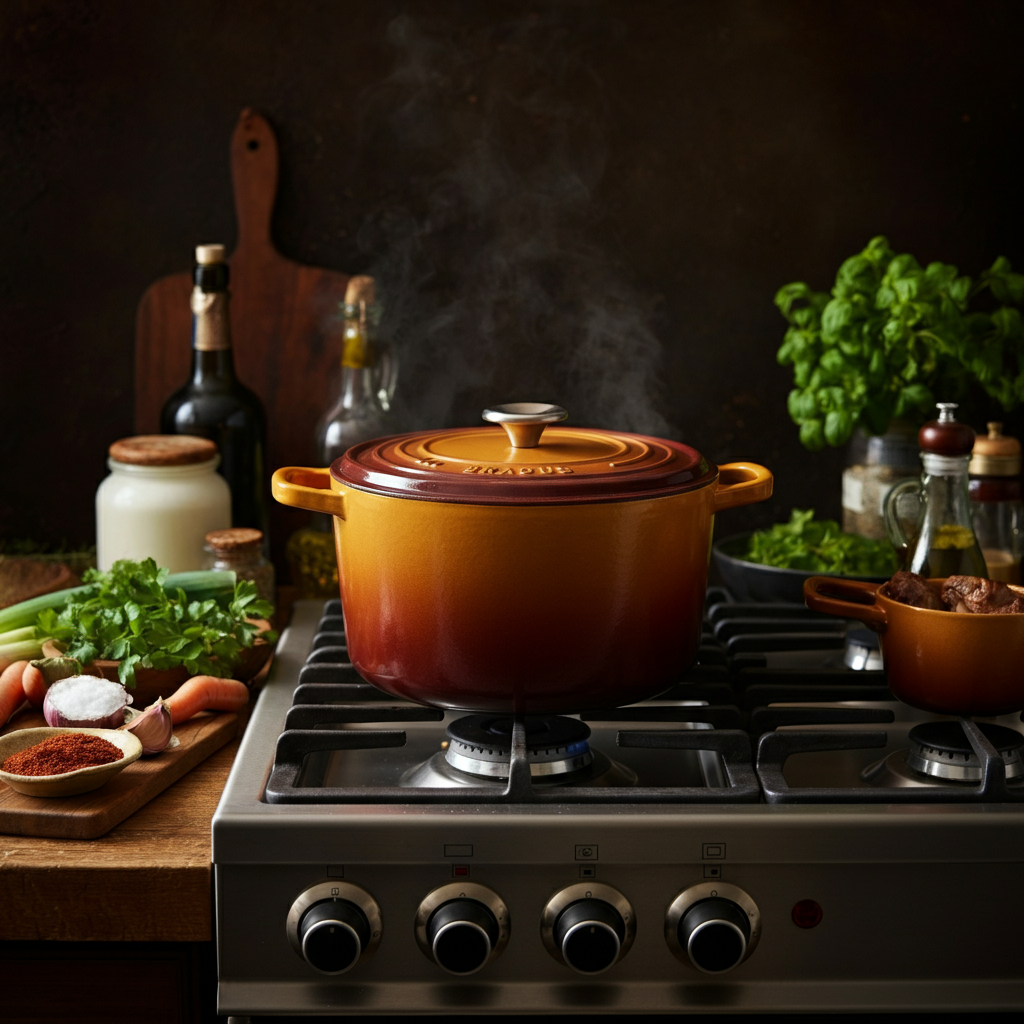








 Subscribe to our free newsletter for tips, tutorials, and insights!
Subscribe to our free newsletter for tips, tutorials, and insights!